
New World Quarantine Page Menu: 1 2 3 4 5 6 7 8 9 Next>>
New World Quarantine During the Golden Age of Piracy, Page 8
Quarantine Locations in the New World in the 17th and 18th Centuries
The New World did not have formal maritime lazarettos like those built in the Mediterranean. Nor did they establish many long-standing quarantine locations in the English fashion. Instead, quarantine was performed in a patchwork manner, being put in place by local governments for certain periods or even by applying them to certain ships following reports of diseases like smallpox and, later, yellow fever in ships arriving or coming from reportedly infected ports. A 'quarantine hospital' was built near Boston in 17181, but it was the only example that was in any way similar to the methods employed in the Mediterranean.
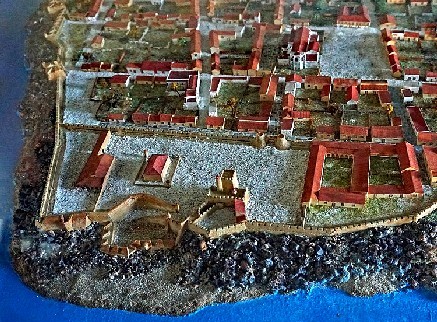
Photo: Mario Roberto Durán Ortiz
Model of the Ozama Fortress, Establish in Santo Domingo in 1502. It Appears Here
As It Did Circa 1785, Model From Museo de las Casas Reales
Historian Donald Hopkins says one of the earliest examples of quarantining ships by the Spanish occurred following several outbreaks on Hispaniola in the early 16th century. "[S]hips from Spain usually halted at Puerto Rico or San Germán [a separate municipality on the island of Puerto Rico] first, where any smallpox that developed
during the voyage should have been discovered."2 Doctor and historian Aristides Moll establishes what he considers the first Caribbean quarantine measures which following a widespread smallpox outbreak in Santo Domingo (modern Dominican Republic) during 1517-8. authorities in the Dominican Republic.3 He explains that these measures required all arriving ships be inspected by of "an
alcalde [local magistrate] and a notary public [who] visited all arriving vessels to see whether
any sick people were on board and ...forbid their landing, the
other passengers being placed under observation for four or five
days."4
In 1603, slave ships coming from Africa brought smallpox to Buenos Aires resulting in six epidemics, bringing commerce there to a halt. As a result, the authorities ordered the quarantine of incoming slaves in tents on on the outskirts of the city beginning in 1621.5 The next year, Peru similarly ordered quarantine of slaves arriving on ships. Viceroy of Peru Francisco de Borja y Aragón (who was in charge of the Peru at that time) ordered all new slaves quarantined and inspected for smallpox in 1630.6
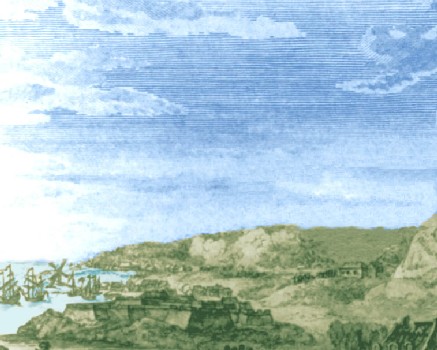
Artist: Nicholas Ponce -
St. Christopher, From Attaque de Brimstomhill, (c. 1784)
There are a few examples of limited quarantine in the Caribbean found in the English records, although it is likely that other Caribbean islands employed it for brief periods. Some of these examples only suggest quarantine may have been used. For example, in April of 1668, Barbadian Governor William Willoughby mentioned in a letter to Undersecretary Joseph Williamson that he travelled to Nevis in his majesty's ship the Crown, which "Lay there three weeks and had at one time 60 sick men in his ship, 18 with the small-pox, and the captain thought he escaped well."7 Whether the three weeks spent at anchor was a locally-directed or self-imposed quarantine isn't clear.
More directly stated, the Nevis Council and Assembly Minutes of April of 1699 recorded, "H.M.S. Queenbrough, having returned from cruising after Capt. Kidd, had lost above 23 men by a contagious sickness, and put 20 odd men sick ashore". As a result, since small-pox was "very violent in the French part of St. Christopher's, a proclamation was issued forbidding any person to come ashore thence without licence from the President and Council."8
In 1701, the Council of Bermuda voted for a motion by Charles Walker which "ordered that no person who came in her [the ship Charles, known to be infected with smallpox], except those who have been ashore for 10 days, come on shoar this whole week, and those on shore do not go aboard"9. This is an interesting example of a very specific quarantine.
Governor John Hart of the Leeward Islands advised the Council of Trade and Plantations
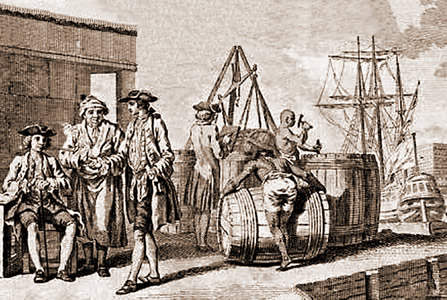
Artists: Joshua Fry and Peter Jefferson -
Cartouche, Map of Virginia and Maryland (1751)
that St. Christopher had established a more permanent example of quarantine in 1722. This read: "An Act for enjoyning all vessels or persons infected with the plague, small pox or other contagious distempers, to perform a due quarantine, and to prevent as much as may be the dangers with which this Island is at present threatn'd by the smallpox being already therein."10 It was still under discussion at Whitehall in January of 1724,11 so it must have been in place for at least those years.
However, most of the examples we have of quarantines in the New World come from North America. Hopkins explains, "To many European colonists in the small port cities along the eastern coast of North America, however, it was clear that epidemics resulted from ill persons arriving on board ships, from which the disease spread. In these small North American ports, the infection died out between epidemics, as the population was not yet large enough to maintain the infection endemically."12 To protect themselves, local governing bodies began establishing quarantine regulations in populous locations most effected by these epidemics during the golden age of piracy. Examples of quarantines which were put of short duration can be found between the years 1647 and 1722 in locations which include Massachusetts (primarily around Boston), New York, South Carolina and Philadelphia.13
1 John Duffy, Epidemics in Colonial America, 1953, p. 103; 2 Donald Hopkins, The Greatest Killer, 2002, p. 204-5; 3 Hopkins, p. 205; 4 Aristides A Moll, Aesculapius in Latin America, 1944, p. 75; 5 Moll, p. 529 & Nunzia Locatelli & Cintia Suarez, "La epidemia de viruela que sacudió a Buenos Aires en 1621 y los rezos a San Roque"; infobae.com, gathered 7/27/20; 6 Hopkins, p. 216; 7 Calendar of State Papers Colonial, America and West Indies (CSPC): Vol. 5, Item 1724 8 CSPS, Vol. 17, 1699, Item 463; 9 CSPS: Volume 19, 1701, Item 690; 10 CSPS: Volume 33, 1722-1723, Item 578; 11 CSPS: Volume 34, 1724-1725, Item 6; 12 Hopkins, p. 238; 13 Susan Wade Peabody, "Historical Study of Legislation Regarding Public Health in the States of New York and Massachusetts, The Journal of Infectious Diseases, Supplement No. 4, Feb. 1909, p. 145
Quarantine in Massachusetts, 17th and Early 18th Centuries
The first North American quarantine was instituted in Boston in 1647. Colonial lawyer John Withrop recorded in his journal that following a 'plague, or pestilential fever' which killed people within three days in Barbados and St. Kitts, "the court published an order, that all vessels, which
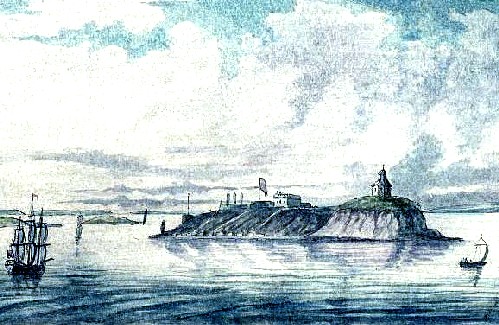
Castle William in Boston Harbor, From The American Revolution in Drawings and Prints (1770)
should come from the West Indies, should stay at the castle [Castle William, on an Island in Boston Harbor], and not come on shore, nor put any goods on shore, without license of three of the council, on pain of one hundred pounds, nor any to go aboard, etc., except they continued there, etc., on like penalty."1 Withrop adds that Salem and some other enacted similar orders. This order was repealed two years later by the court.2
The ruling doesn't seem to have been followed very consistently. Withrop mentions a ship coming from St. Kitts ignoring the rule, lying to the officials on the boat sent to meet them saying that they hadn't come from the West Indies. The crew told the council the next day that the illness there had ceased three months before and so there was no danger of the crew being afflicted, which the council apparently believed. So "they gave them [the crew] liberty to continue on shore; but for cotton and such goods as might retain the infection, they ordered them to be laid in an house remote, and for [the ship's master Goodman] Dell, he was bound over to the next court to answer his contempt."3
Another ship arriving from Barbados was stopped at Castle William resulting in the ship's master and two sailors being brought to Boston, something Winthrop notes should not have happened.
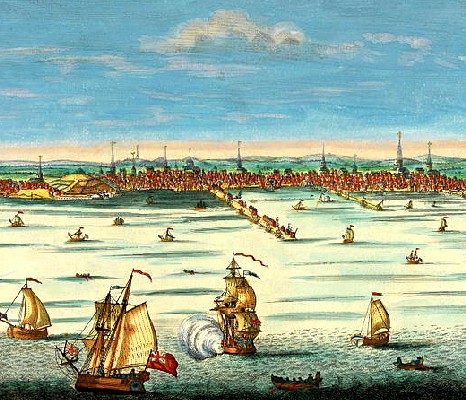
Artist: John Carwitham - A South-East View of the City of Boston (c. 1720-40)
"Four magistrates examined them upon oath, and finding they were all well, save two, (who had the flux [diarrhea],) and no goods from Barbados but three bags of cotton, which were ordered to be landed, etc., at an island, the ship was suffered to come up, but none to come on shore for a week after, etc."4
A quarantine was issued in Boston on October 11, 1665, although this one was directed primarily at preventing the plague. Issued by a warrant of the court against William Foster's ship in particular and other ships like his, it ordered, that no one was to aboard such ships "w[i]thout such like licence, on pœnalty of imprisonment, that so the dainger of the pæstilence may be prevented as much as maybe & that the captain of the Castle stop all vessells coming from England"5. Similar to the 1647 order, quarantined vessels were once again to anchor at Castle Island in Boston Harbor (shown in red in the map below left) and bring their goods up, presumably to be aired. This order was repealed two years later.6
Several individual orders were enacted against incoming vessels to protect the area. Thomas Jenner's ship John and Thomas arrived in Boston in July, 1677 with someone aboard apparently either having or having died from smallpox. This may have been a passenger from England, Frances Willoughby, who Thomas Clark recalled in 'July of 1677 or 1678' "died on board [Captain Jenner's] ship of ye distemp[e]r of ye Small Pox, and was then... solemnly thrown overboard into ye Deep"7. The Governor and Council in Boston, "understanding that Gods Aflicting hand has been upon them by the Infectious Disease of Small Pox... for the prevent of the further spreading of that Infectious & noysome Diesease amongst the Inhabitants"8 ordered Jenner to bring the passengers and goods to an uninhabited island in the harbor.
In September of 1677 an order in Marblehead, Massachusetts (about fifteen miles north of Boston) likewise directed "that no passenger or seamen [from a ship Captained by a Mr. Legg shall] presume to Come ashoare to Boston or any neighboring Town till they have bin ashoare on some of
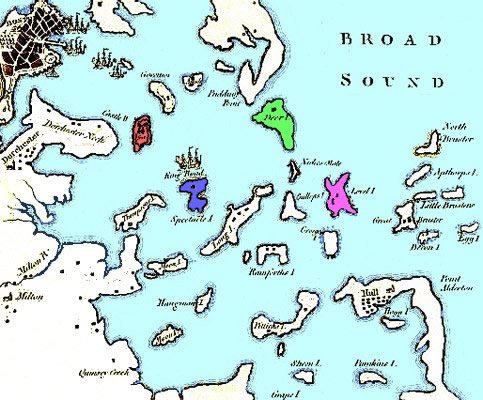
Cartographer: J. de Costa
Boston Harbor Quarantine Islands Mentioned: Castle Island (red),
Deer Island (green),
Lovells Island (purple) and Spectacle Island (blue) (1775)
the Islands as Deare Island Ayring themselves and cloathes for eight dayes on penalty of the forfeiting of fivety pounds apeece for any so doing untill the Council take further order"9 Around this time, Deer Island (colored green in the map at left) served as a place for internment for Native Americans.
During the spring of 1680, the commissioners and selectmen noted that "itt hath pleased god to vissett the Inhabitants of barbadoes with the small pox which is an infectious distemper and severall vessells being expected from thence, itt therefore being our duty that all due care may bee taken to prevent itts being brought in amonght us"10. As a result, they ordered that all vessels sailing from Barbados had to be examined by James Poland and/or John Clifford (neither of whom seem to have been medical men) before they could disembark, or unload goods. Further, no one else was to go aboard such vessels "upon there uttermost perrill, untill a tru Acc[oun]t bee given to the Selectmen of there health & condition thay are in by the s[ai]d persons Impowered & soe an order from the Selectmen may bee given forth either to licenc them or further to prohibett & forbid According as the case may justly require"11. Nothing about how quarantine was to be conducted is specified in this order, however.
Samuel Sewall noted in his diary on August 1st of 1685 that the Council issued an order to the vessel of a 'Shipmaster Condey' which had smallpox aboard "to remove lower to Lovel's Island (colored purple in the map above left), and there the Passengers, Ship, and Goods between Decks to be Aired: None to come to any Town till further Order. And None to entertain persons coming from the Ship."12
Another Boston quarantine law, 'An Act For The Better Preventing Of The Spreading Of Infectious Sicknesses', was passed in July of 1699. It was composed of three distinct sections. The first section addressed the responsibility of a ship's captain:
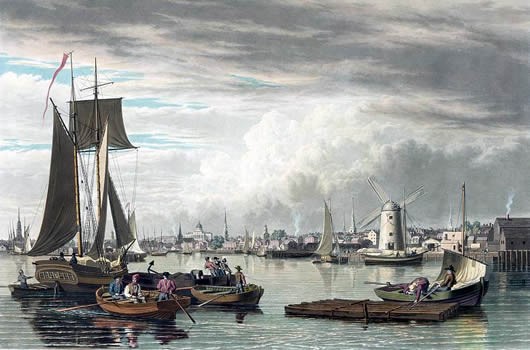
Artist: William J Bennett - Boston from City Point near the Sea Street (c. 1833)
That no Master or Commander of any Ship or Vessel arriving to any Port or Harbour within this Province, in which Ship or other Vessel, any person, Passenger or Seaman upon their Passage shall be visited with the Small Pox, or any other contagious Sickness; Or shall come from any Port or Place where any such Sickness is Epidemical and prevailing, may presume to Sail, or bring his Ship or Vessel within or above the Castle or Fort (where any such is) or within the space of half a mile next unto any Peer,Wharf, or Landing place in such Harbour where no Fortification is, without Licence first had for so doing from the Governour or Commander in Chief of this Province for the time being, or from the two next Justices of the Peace. Nor shall permit or suffer any of his Passengers or Seamen to be Landed or brought on Shore; or any person or persons to come on Board without Licence as aforesaid first had and obtained for the same, on pain that every Master or Commander of any Ship or other Vessel offending against this Act, shall forfeit unto His Majesty the Sum of One Hundred Pounds13
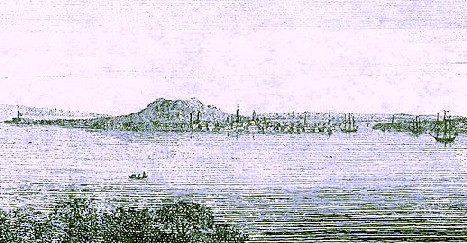
Boston Harbor, From The Atlantic Neptune marine atlas (CA. 1777)
The second section explained how the law was to be communicated to ship's captains and responsibilities of the officers at fortifications which were responsible for overseeing its application. The last section discussed punishment for those flaunting the law. They, their clothing and bedding, were to be put back aboard their vessel, or the officers were "to confine them to such other place or places as such justice shall judge most suitable for preventing of infection; and all the cost and charges arising thereupon to be answered and paid by the passenger or seaman so offending as aforesaid, who also shall forfeit the sum of twenty pounds"14.
While expanded, this law similar in many ways to the order of 1647 including the 100 pound penalty. Yet the law was disallowed by the Privy Council at the request of the Lords of Trade. They explained:
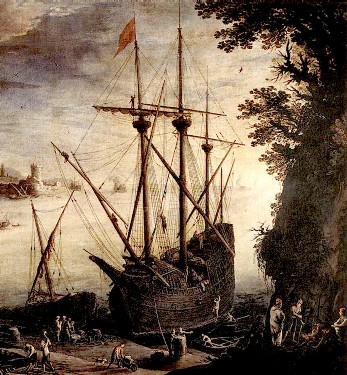
Artist: Paul Bril - Ship in Port (1611)
There is no such act as this (that we know of) in any other of his Majesty's plantations; And by the uncertain interpretation that may be put upon the terms Contagious, Epdemical. and Prevailing Sickness, we think it may be liable to great abuses; The penalties thereby inflicted seem to us too high. And we are therfore humbly of opinion that the inconvenience thereby intended to be prevented may be better provided against by order of the Governor and Council from time to time than by any standing Act of the General Assembly.15
As a result, Massachusetts passed another, modified act in 1701 called 'An Act Providing in Case of Sickness.' This consisted of four parts, the first two of which dealt with contagious illness on land, the third was procedural and the fourth addressed maritime quarantine. It much shorter than the 1699 law, although the scope was wider. It applied to "any person or persons, seamen or passengers, belonging to or transported in any ship or vessel, arriving to any port or harbour within this province, [who] happen to be visited with the plague, small pox, pestilential or malignant fever, during the voyage, or to come from any place where such sickness prevails and is common"16. However the teeth of the previous bill had been removed. Those coming ashore before quarantine expired were to be put back on their ship, and then the governor or 'commander-in-chief' was "impowred, with the advice and consent of the council, to take such further order therein as they shall think it for preventing the spreading of the infection."17 That was apparently vague enough for the Privy Council and the Lord of Trades; the law remained in effect until 1797.
The closest any of the colonies got to establishing a lazaretto was the establishment of a committee "to investigate a suitable place for a hospital for contagious diseases". As a result, a part of Spectacle Island (shown in blue on the previous map of quarantine islands in Boston Harbor) was bought for that purpose in August, 1717 and a 'province hospital' erected.18 The Council noted that the purpose of this "Hospitall or Pest House there [was] for the reception and entertainment of sick persons comeing from beyond sea, and in order to prevent the Spreading of Infection."19
 Photo: Wikimedia Contributor MrPanyGoff - Spectacle Island (Foreground) in Boston Harbor |
1 John Withrop, Winthrop's Journal, Vol. 2, James Kendall Hosmer, ed, 1903, p. 329; 2 Susan Wade Peabody, "Historical Study of
Legislation Regarding Public Health in the States of New York and Massachusetts, The Journal of Infectious Diseases, Supplement
No. 4, Feb. 1909, p. 41; 3 Withrop, p. 329; 4 Withrop, p. 329-30; 5 Legislature of Massachusetts, Records of the governor and company of the Massachusetts bay in New England, v.4:2, p. 280; 5 Massachusetts State Board of Health, Manual for the Use of Boards of Health of Massachusetts, 1886, p. 5; 6 Laura K. Donohue, "Pandemic Disease, Biological Weapons, and War", Law and War, Austin Sarat & Lawrence Douglas, eds., 2014, p. 135; 7 New England Historic Genealogical Society, The New England Historical and Genealogical Register, Vol. 31, 1995, p. 309-10; 8 "Order to Thomas Jenner", cited in John B. Blake, Public Health in the Town of Boston, 1630-1822, 1959, p. 19; 9 The Essex Institute, "Documents Relating to Marblehead, Mass", Historical Colections, Vol LIV, 1918, p. 276; 10 The Essex Institute, "Salem Town Records: Town Meetings, Vol III", Historical Colections, Vol LXII, 1926, p. 86; 11 "Salem Town Records: Town Meetings, Vol III", p. 87; 12 Samuel Sewall, Diary of Samuel Sewall, Vol I 1674-1700, 1878, p. 91; 13 Massachusetts, Acts Relating to the Establishment of Quarantine, 1881, p. 9-10; 14 Massachusetts, Acts Relating..., p. 10; 15 Peabody, p. 42; 16,17 Massachusetts, Acts Relating..., p. 11; 18 Peabody, p. 43; 19 Massachusetts, Acts Relating..., p. 13

